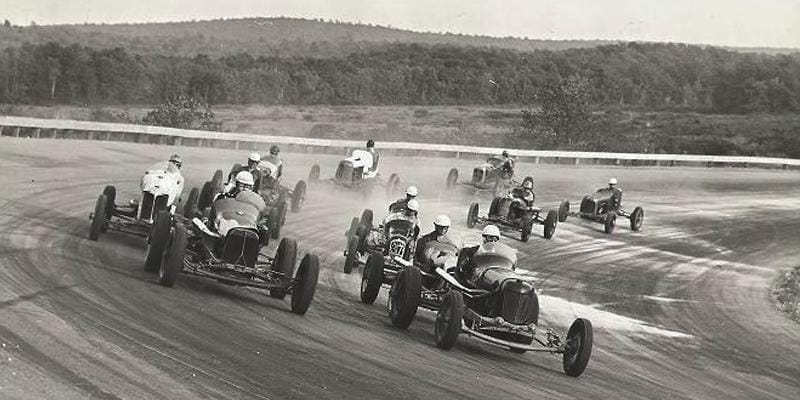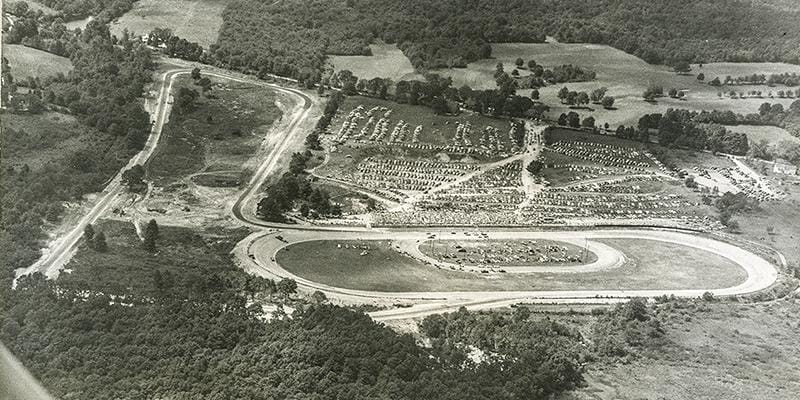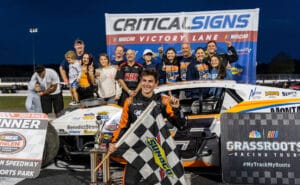Track History

The Thompson Speedway story begins on a quiet September afternoon in the farming community of Thompson, Connecticut. The year was 1938. With no advance warning, the skies turned black as huge storm clouds raced over the area. The “Long Island Express” was ready to bear down on New England. The affects were devastating as the famous 1938 hurricane roared through this quiet farming town. When the skies cleared, buildings, trees and just about anything in the storm’s path had been destroyed. Included was the farm of John Hoenig and his family. In the aftermath of the storm called the “Long Island Express” and The Great New England Hurricane, many chose to rebuild. Some chose to pull up stakes and move elsewhere. However, John Hoenig had a dream. If ever that dream were to become reality, now was the time. He began to remove the downed trees and clear the land. He brought in a rock crusher, built a sawmill, and moved thousands of cubic yards of gravel. All of these items were needed to create his dream. Before long, the nation’s first asphalt racetrack was beginning to take shape and John Hoenig’s dream was coming true.
By the standards of the day, a .625-mile, high-banked racetrack was huge. Most tracks had dirt, boards or bricks as surfaces and were ¼ mile in length or less. But, in spite of the critics, Hoenig persevered and on May 26, 1940, the gates opened for the first time to a capacity crowd. The word of this new “Super Speedway” spread across the country and soon Thompson became known as the “Indianapolis of the East.”
Nearly every big name driver in the country set his sights on Thompson, CT. The track became a Mecca for auto racing drivers and fans. Next came the addition of a ¼ mile oval track that was built inside the much larger original track. This track was used to accommodate the growing stock car and jalopy racing groups since the “big track” was too fast for the technology of these cars of this time. During the 1940s, the oval began attracting sports car enthusiasts. Members of the newly organized SCCA would hold time trials and Gymkhanas using parts of the oval and the infield ¼ mile track. From 1952-1967, the oval track and an adjacent section of the Speedway property were leased to owners of the neighboring sports car track, the Thompson Raceway.
In the late 1960s, Thompson Speedway opened the road course known as Thompson Version 3. This configuration included re-designed turns from the original 1952 layout, updated viewing areas and paddocks. Thompson, Connecticut had, indeed, become the center of auto racing in the northeast as well as a known motorsports destination in the United States.
When the glory days of the “big cars” and midgets began to fade, Thompson became a leader in what has become known as Stock Car racing. Thompson Speedway’s first event for the newly organized NASCAR Grand National cars came on October 12, 1951. The one hundred mile, 200 lap event saw 38 cars take the green flag. NASCAR’s biggest names of the day were on hand. Drivers like Tim Flock, NASCAR Champion Herb Thomas and Jim Reed led the Grand National line up which also included some very famous New England drivers like Jerry Russo, Dave Humphrey and Reino Tulonen. The event was won by Neil Cole, who drove a 1950 Oldsmobile to victory and collected one thousand dollars for his efforts. In 1969, NASCAR’s Grand National (now Sprint Cup) division returned to the “Big T”. The 1969 rendition saw David Pearson in victory lane. The 1970 race was won by Bobby Issac.


During the 1947 year of motorsports operation, the facility also developed the Raceway Golf Club – which boasts 18 holes of classic New England golf course design – and Raceway Restaurant that hosts large race banquets, weddings, and parties and outings of all types. In addition it houses the famous raceway bar and lounge that accommodate both racers after a night on the track or a foursome coming in after playing 18 holes. It is a unique dynamic to sit in the one of the seats of the lounge and imagine all of the greats who have passed through after a race as you look over the historic facility.





